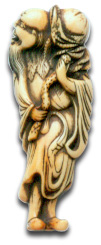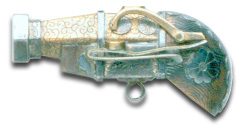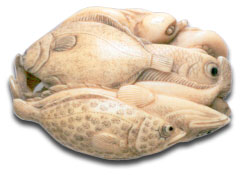Although netsuke were originally made as a dress accessory, their lively and intricate carvings have been accepted as art objects in the West for more than a century.
Though small, netsuke often bear a wealth of decorative detail that is a great part of their charm. Their subjects, ranging from gods and demons to humble plants and animals, have much to say about both the interior and exterior lives of the Japanese people.


By the 1880’s, oriental artefacts, and in particular those made in Japan, were in vogue among discerning buyers in parts of western Europe.
The delicate artistic quality of all things Japanese had a powerful appeal.
This was particularly true of the tiny carvings known as netsuke (pronounced ‘netskee’) which collectors would display as exquisite ornaments around the home.
Ivory netsuke of an Immortal, Edo Period, sold at auction in 1997 for $1,150 including premium.
Take a look at the Antique Japanese Netsuke on eBay!
In Japan, netsuke were not ornaments but practical, everyday items of dress. Japanese man and women wore robes held together by a broad sash.
They didn’t have any pockets, so the sort of small items that needed to be carried about were hung from a cord tucked under the sash and secured with carved toggles. These toggles were the netsuke that were so eagerly collected abroad.
The origins of netsuke are obscure, but they were in general use by the 1600s and became increasingly popular and more skilfully made as the objects that were hung from them took on greater fashionable importance.
Potions, Purses and Pouches
The best known accessory was the inro, a small box used by the wealthy for carrying medicine and seals. Fine netsuke were also used to secure the purses of rich merchants and the these became important status symbols, rivalling the totems of the higher classes.
However, netsuke were used most widely of all by the lower classes, to hold the tobacco pouches that became almost universal after the introduction of smoking to Japan.
As everyday functional objects, netsuke were not especially esteemed in Japan. Carvers tended to produce them in spare moments as a way of using up left-over materials which they were working for other purposes.
Even so, they were carved with consummate skill and care despite being small enough to fit comfortably into a closed fist.
There are several types of netsuke, carved into a large variety of subjects. Among the most common are the round or square button-like boxes known as manju, after the rice cakes which they resemble.
Most numerous of all are katabori, the figures which represent the heroes and villains, mortals and gods, and real and mythical animals which make up Japanese folklore and history.
Plants, masks, musical instruments, tools, implements, fruit and vegetables also appear. Indeed, a large collection of netsuke would make up an almost complete picture of life in old Japan.
The materials used were as varied as the subjects, although wood, the most easily carved, was the most common. Boxwood was especially popular, since it was hard and fine-grained.
Japanese cypress, sweet-smelling and fine-textured, was also greatly admired.
After wood, ivory was the most widely used material, but great numbers of netsuke were also made from bone, shell, horn, fruit stones and even various kinds of metal.
Take a look at the Antique Japanese Netsuke on eBay!
Netsuke Collector’s Notes
By the 1870s, the demand for netsuke in Japan was dwindling, since the Japanese were taking to western clothes and cigarettes were replacing the traditional pipe and tobacco pouch.
But it was at just this time that netsuke were becoming known and valued by western connoisseurs such as the French writers Jules and Edmond de Goncourt, who pioneered the cult of japonaiserie in Britain and France.
The Japanese continued to make netsuke, but increasingly for the export trade and in rather debased forms – reflecting the decline of the traditional culture.
However, some skilled carvers did continue to work on into 20th century, and in more recent times there has been a revival of the art.
These days netsuke can be found in specialist dealers or for sale through auction houses. Take a look at the Antique Japanese Netsuke on eBay!
However, collecting is not without problems, since it is almost impossible to authenticate or date netsuke except after many years of close study.
Although certain generalizations can be made – such as earlier examples being more simply carved, and everyday scenes being most popular in the 19th century – there are few absolutely accurate guidelines to follow.
Even the signature on a piece may not be much help. Pupils often used their master’s signature on their own works.
Other markings and inscriptions have been known to baffle native Japanese, due to the frequent use of obscure and complex abbreviations.


And to cap all this, copies and ingenious fakes have spread with the steady rise in value of netsuke. All these pitfalls demand placing your faith in a highly reputable and expert dealer, especially if you’re spending large amount.
Soft metal netsuke cast in the form of a match-lock pistol, Meiji Period, sold at auction in 1997 for $1,725 including premium.
Netsuke is Miniature Sculpture at it’s Finest
Netsuke is a form of miniature sculpture particular to Japan and one with no counterpart in Western culture. The proper pronounciation for netsuke is “net-skay,” and the term is never pluralized.
Netsuke exist because the kimono is constructed without pockets. In place of a pocket, the Japanese used an inro (sectioned box) to hold items such as money, tobacco, and writing implements.
The inro — with a cord drawn from the top under the kimono’s sash — was counterbalanced by a netsuke. This prevented the inro and cord from slipping through the sash.
Netsuke are usually carved from ivory or wood, but some are made of stag antler, bamboo, porcelain, metal, or other rare materials. Generally between one to two inches high, netsuke differ from purely decorative forms of sculpture in that their practical use imposes strict limitations on design.
Netsuke must be compact and free of projections that might catch on kimono sleeves.
They must be durable enough to withstand wear from daily use and strong enough to support the full weight of the inro. Furthermore, a netsuke’s design must not be spoiled by the holes necessary for insertion of its cord.
The height of netsuke carving occurred during the Tokugawa period (1615-1868) when Japan was cut off from the rest of the world — except for a nominal Dutch and Chinese trading post at Nagasaki.
This isolation is responsible for one of the most fascinating aspects of netsuke — they were produced by and for Japanese, solely to their taste and subject matter.
Netsuke subjects, style, and treatment express the character of the Japanese people.
The introduction of Western dress to Japan brought about the demise of netsuke as a functional object. But in some respects they are more alive today than ever before.
Collector’s Market for Netsuke
Netsuke collectors are extremely active. Scholarly books, publications, and netsuke study societies abound. The earliest collections of netsuke were formed in Europe and are well documented.
American collectors have also made their mark in the field. Almost any antiques fair will have netsuke for sale. It is possible to buy netsuke from fine collectors for a few hundred dollars.
Take a look at the Antique Japanese Netsuke on eBay!
Netsuke from important collections come up for sale at auction regularly, and it is still possible to buy some of the finest examples for a fraction of what masterpieces in other fields would cost.


As netsuke were carved in great quantity, it is also possible (with a bit of knowledge and luck) to find undiscovered treasures. Novice collectors should educate themselves through reading and handling as many netsuke as they can find.
Ivory netsuke of a pile of fish, Edo Period, sold at auction in 1997 for $4,025 including premium.
How to start Collecting Japanese Netsuke
A good book of signatures is essential for beginning collectors.
Although netsuke carvers were often renowned for their renditions of a certain form, it was not uncommon for a student to sign his master’s name as a way of relating his creation back to the master’s work. This makes questions of authenticity extremely difficult.
In addition, some of the finest examples of netsuke are unsigned, thereby rendering authentication impossible — and prices lower.
Beginners can start a collection by focusing on: specific subjects such as frogs, oxen, or erotica;
an appealing medium — boxwood, metal, or ivory are examples;
or certain forms such as the kagamibuta (in the shape of a bowl and disc) or manju (shaped like rice cakes).
There’s no better way to begin collecting than by handling the pieces yourself and talking with collectors and dealers. If you’re interested in expanding into a new field — Take a look at the Antique Japanese Netsuke on eBay!
Further Reading:
Netsuke: Japanese Life and Legend in Miniature by Edwin Symmes
The Ultimate Netsuke Bibliography: An Annotated Guide to Miniature Japanese Carvings by Norman Sandfield
Japanese Netsuke in Oxford by Oliver Impey
Netsuke, Familiar and Unfamiliar: New Principles for Collecting by Raymond Bushell
Netsuke by Patrizia Jirka-Schmitz
Netsuke: The Japanese Art of Miniature Carving by Matthew Welch, Sharen Chappel
Japanese Treasures: The Art of Netsuke Carving in the Toledo Museum of Art by Carolyn Putney
Inro to Netsuke by Tokyo National Museum
Netsuke: Fantasy and Reality in Japanese Miniature Sculpture by Joe Earl
Related feature stories
Collecting Old European & Chinese Snuff Bottles
What are Garnitures? Mantelpiece decorations, usually vases
Value of Collecting Chinese Porcelain. Chinese Dynasties
Why Collect Asian Art? What to collect
Japanese Pottery: Satsuma & Japanese Era Names (Nengo)
National Gallery of Victoria sets a new world record with House of Chanel purchase





